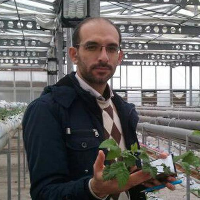Effect of Silicon Nutrition on Strawberry cv. Camerosa Yield and Growth in Outdoor Hydroponic System
Strawberry is one of the important small fruits worldwide because of its high economical value. Mazandaran is ranked second among Iran’s strawberry prodcing provinces with about 14581 tones of strawberry yearly. This research aimed to evaluate the effect of different silicon sources on the reproductive and vegetative growth of strawberry in an outdoor hydroponic system.
This experiment carried out in a factorial format with two factors consisting of growth media (double medium: 1 cocopeat + 1 perlite, and triple medium: 1 cocopeat + 1 perlite + 1 rice husk) and silicon spray (control, 50 mg/L Si from sodium silicate, 100 mg/L Si from sodium silicate, 50 mg/L Si from potassium silicate, 100 mg/L Si from potassium silicate). It was performed in Sari Agricultural Sciences and Natural Resources University at 2016. Different characteristics including silicon concentration in the leaf, aerial fresh and dry weight, leaf number, fresh and dry weight of crown, fresh and dry weight of root, yield, weight of single fruit, number of the produced fruits in each plant were evaluated.
Potassium silicate 100 increased silicon concentration of strawberry leaf significantly. Leaf number of the plant and aerial dry weight in triple medium were significantly higher than the double medium. High rate of potassium silicate in the triple medium caused lower crown diameter in comparison with potassium silicate 50 in the same medium. However, in the double medium, the potassium silicate 50 was the best treatment for crown diameter. Both fresh and dry weight of strawberry roots were the highest in the double medium and potassium silicate 50 treatment. Single fruit weight was maximum in the double medium and potassium silicate 100, which was not significantly different from potassium silicate 100 in triple medium. Fruit dry matter in the double medium and potassium silicate 50 treatments was more than other treatments. Fruit size was affected by medium, so that fruit size in the double medium was more than the triple medium significantly.
Sodium toxicity in sodium silicate treatment, low rate of silicon in potassium silicate 50 treatment, and lack of rice husk in the double medium could all negatively affect different physiological aspects of strawberry growth; or at least, they hindered achieving positive results. In summary, it can be concluded that the double medium and potassium silicate 100 can be recommended for higher yield and big strawberry fruit, but the triple medium and potassium silicate are useful treatments for vegetative growth specially for more crown diameter and root growth.
-
The Effect of Applying Organic Compounds on the Amount of Lead, Nickel and Cadmium in Urban Sewage Sludge (Case Study: Sewage Sludge in Sari Refinery)
Mohammadali Bahmanyar *, Seyed Mostafa Emadi, , Mehdi Hosseini
Environmental Sciences, -
Estimation of Chilling and Heat Requirements of Thorny and Thornless Blackberry Cultivars Under Laboratory Conditions
Somayeh Tabari, Mehdi Hadadinehjad*, Reza Noruz
Journal of Horticultural Science and Technology, -
Investigation of Growth and Photosynthetic Characteristics of Strawberry Daughter Plantlets Influenced by nitrogen fertilization of maternal plants
Amirali Mohammadi *, , Kamran Ghasemi
Journal of Plant Production, -
New records of springtails (Hexapoda, Collembola) for Iran from the Bula Hyrcanian forest
Masoumeh Shayanmehr*, Elham Yoosefi Lafooraki, Thomas Tully, Cyrille Dhaese, Mehdi Ghajar Sepanlo
Journal of Insect Biodiversity and Systematics, Mar 2024




